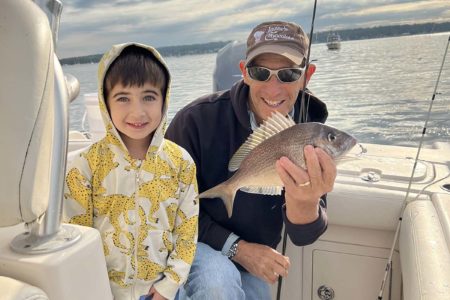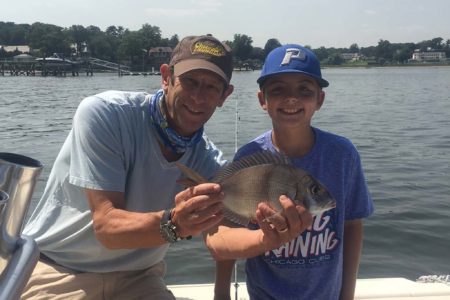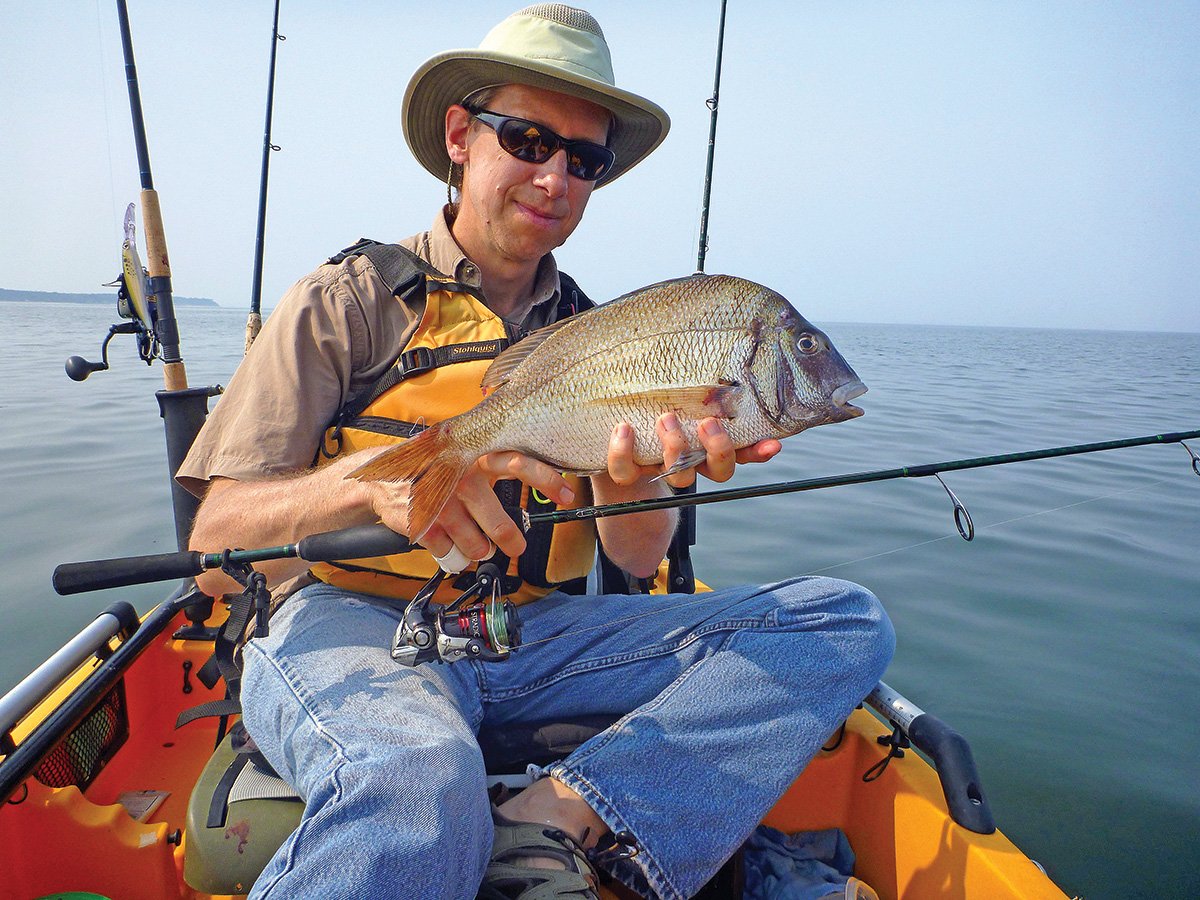
We live in the age of porgies. Sure, fluke numbers are good, sea bass too, and we are fortunate to enjoy a still-healthy striper fishery, but no other inshore species has been so consistently abundant over the last twenty or so years than porgies. For the better part of each season, including through the summer doldrums, porgies are to be found in numbers that can, at times, approach nuisance levels. While porgies may be ubiquitous and easy to catch, large ones often prove hard to find for inshore anglers. This can be frustrating, especially when they are the fish you happen to be specifically targeting. Many inshore areas see an initial surge of quality fish in the spring, which peters out as the summer sets in. The big ones are still around, however, if one knows where to look.
During the dog days of summer the most common error many porgy anglers make is to search too deep. In many areas plying depths of 20 to 30 feet turns up a lot of shorts. Sure, there are plenty of large porgies to be found all summer long in deep water locations such as Montauk, eastern Long Island Sound, and in the ocean, but in many inshore areas, the largest porgies are found in the shallows, often in waters less than 15 feet deep. And there is no better way to target shallow-water fish than from a kayak.
Kayaks are ideal for probing the skinny water, allowing one to get cozy with boulders and other fish-attracting structure without the worry of damaging your craft. If you car-top your ‘yak, you will also have access to areas that might be outside of your usual home range. In addition, with this approach to porgy fishing you can leave the boat rods and heavy sinkers at home, enabling you to fully appreciate battling these feisty scrappers. Once you’ve tied into a drag-pulling 17-inch porgy on light tackle, you may never want to go back to chasing them in the depths.
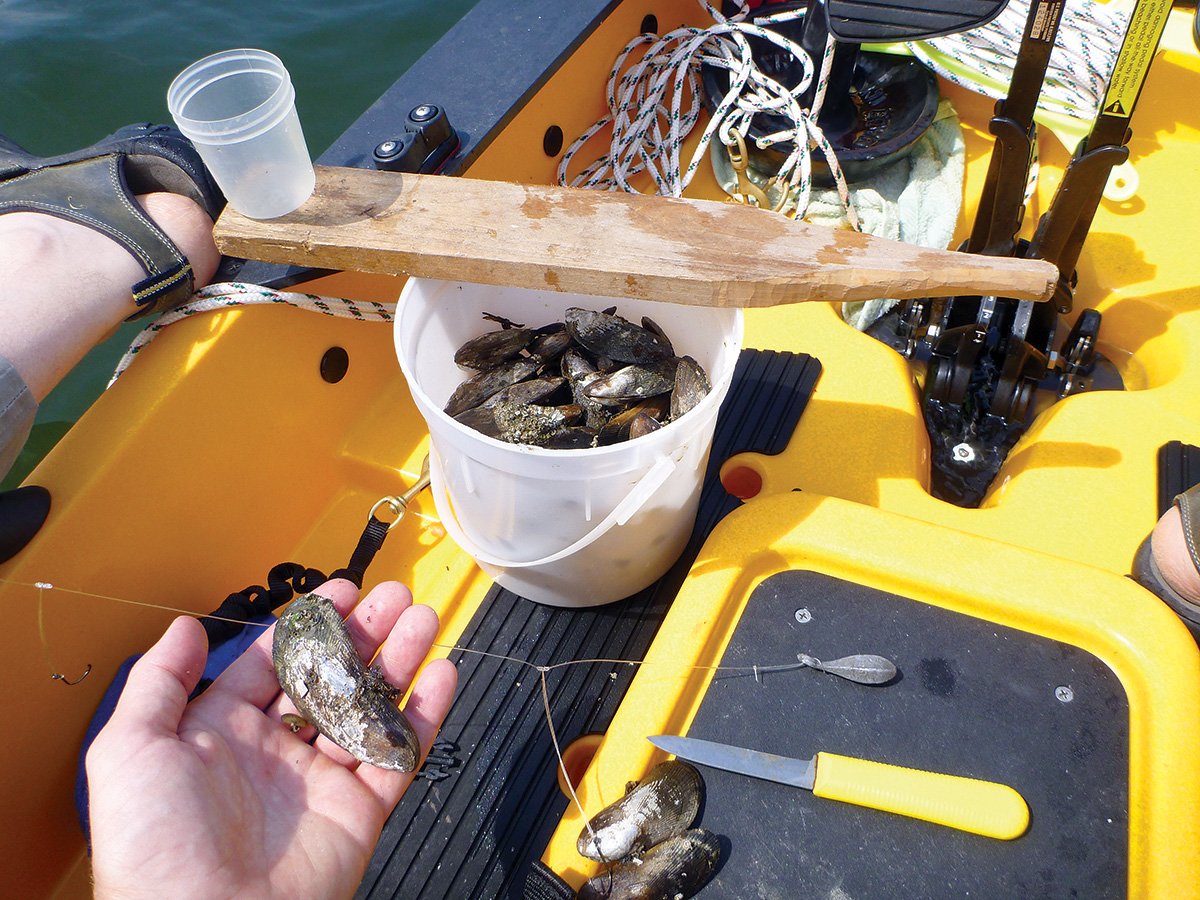
Large porgies don’t inhabit shallow water all season long. It’s a pattern that usually begins in early summer and strengthens into the fall, before tapering off in early October. In Long Island Sound the beginning of July is about the earliest I regularly find them in the skinny. By mid-September the very largest fish are often caught in places so shallow that they are submerged at high tide. That’s where the food is. Porgies are active and free-ranging bottom feeders that have no defined home territory. They roam more or less constantly in search of food. In general, the bottom substrate contains fewer and fewer organisms the deeper one goes, so it makes sense that big porgies would do most of their foraging in the shallows, especially in the fall when they are fattening up for migration. The only downside of targeting shallow water porgies is that often the fish are spread out, and the bite is sporadic. Also, porgies can be skittish in the shallows, and can be spooked even by a boat as small as a kayak.
I’ve used a technique for the last several years to concentrate and hold the fish and consistently produce good catches of quality porgies. It’s is a whole lot of fun too. I like to call it “Crack and Cast.” Use a bat to crack mussels away from the boat and then cast to the fish that the chum has attracted; this avoids spooking them in the very shallow water. Batting mussels or clams for chum is a tactic that has been used for ages on party boats, but when employed in this setting the results can be instant as well as dramatic.
Let’s walk through the prep for our crack-and-cast porgy trip, starting with tackle. You can go as light or as heavy as you want with this kind of fishing, although a lighter rod and reel outfit definitely increases the fun factor. A 6- to 7-foot light to moderate power spinning rod with matching reel spooled with 10- to 15-pound braid suffices under most conditions. I also bring along a somewhat heavier baitcasting outfit in case wind or tide conditions necessitate the use of more weight to hold bottom.
Whenever possible I fish with plain jigheads tipped with bait. My favorites are the Tidal Tails banana head blackfish jigs in the 1/4- or 3/8-ounce sizes. These jigs feature a smaller hook than many other brands of jig, which is perfect for small-mouthed porgies, and I find the shape is snag-resistant as well. If all you happen to have in your box are a bunch of fluke bucktails, no problem. Just snell a #1 octopus hook onto a piece of 30-pound mono and tie the leader onto the bend of the bucktail’s hook so it trails behind the hair by 6 to 8 inches. When fishing, you will only bait the stinger hook. This rig is deadly for big porgies. The highly visible bucktail attracts fish from a distance and draws them in close enough to smell the bait. Whichever rig you chose, always use a 3-foot leader of 30-pound mono or fluorocarbon with a barrel swivel on the top and a snap on the bottom to connect your jig to the braided line from your reel.
If jig fishing is not your thing, a simple bait rig works just fine, too. Take a 5-foot piece of 30-pound mono or fluorocarbon and tie a 6- to 8-inch dropper loop near one end and thread on a #1 octopus hook. Next, tie an overhand end loop for the sinker just below the dropper. Attach the other end of the rig to the braid from your reel with a barrel swivel, and you’re done. The finished rig should be about 3 feet long in total. If tying rigs is not your thing, pre-tied store-bought rigs work just fine too.
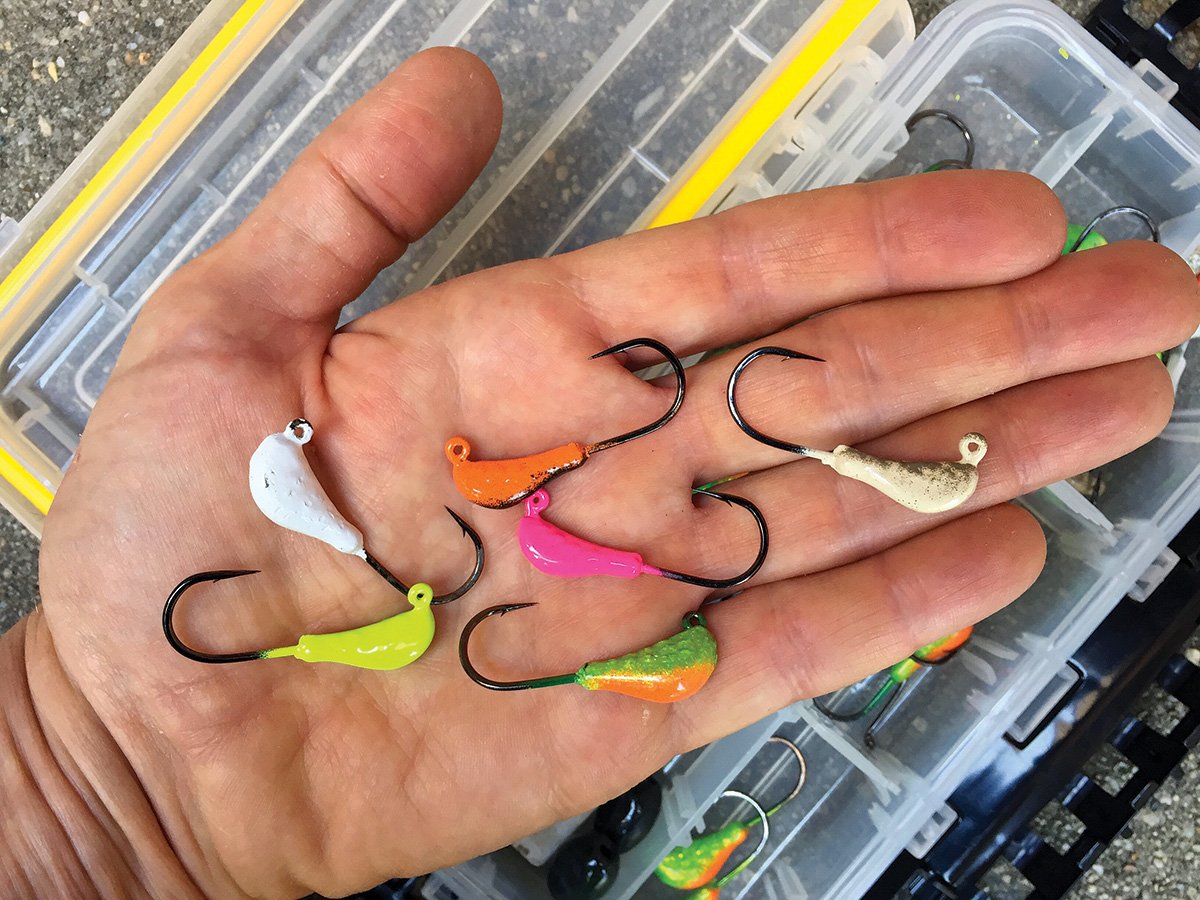
Now let’s talk bait. Porgies have ravenous appetites and are rarely fussy, so a variety of baits work. My personal favorite is clam. Squid works fine too, and has the added advantage of being quite nibble-resistant. Whatever bait you happen to choose, take a few minutes to pre-cut and store it in a small plastic food storage container. This saves valuable time out on the water, and helps keep you from having to cut up bait in your lap. A neat alternative bait is Berkely Gulp!. The smaller sizes of this product work well for porgies. It’s not quite as good as fresh bait, but it’s convenient to use in the close confines of a ‘yak. Just make sure to use a style that doesn’t feature any long-trailing curly-tails. Porgies will nip those off before you can blink!
Now that our rods are rigged and our bait prepped, there is just one more thing we need: bank mussels for chum. These can be purchased at any bait and tackle shop, or you can collect them yourself from any marshy area as long as the tide is out halfway or more. I bring along about a dozen for each hour I plan on fishing. Remember, you’re going to be batting those mussels, so grab a stick, too. I just use a piece of 1- by 2-inch scrap lumber about 18 inches long, with one end whittled down to form a rough handle.
While it’s possible to encounter porgies almost anywhere, there are certain things one can look for to increase their chances for success. First, look for structure in the form of boulders or areas of rocky bottom. Porgies aren’t as intimately associated with structure as blackfish are; you don’t have to actually be on top of the rough stuff, but if you’re in the general vicinity of it that’s a good thing. Porgies also love pebbly sand, and if there are some areas of rougher, cobbly bottom here and there, that’s even better. Avoid areas with oxygen-poor black mud, what I call dead bottom. Most of the beaches on the open Long Island Sound are perfect examples of prime porgy habitat, but I’ve done very well deep inside of harbors as well, especially in September.
If you’re scouting out a new area, try drifting first in 8 to 15 feet of water. When you catch your first keeper, drop anchor. Now the real fun begins. Take your stick or bat and send a half dozen mussels flying out as far as you can. Try to get the mussels to land as close together as possible. Alternately, if you don’t like occasionally getting sprayed with mussel juice, instead of batting the mussels, you can drop back on your anchor line about 15 feet, then tap the mussels in your hand with the bat or even the handle of your knife to lightly crack them. Drop the mussels over the side, then re-adjust your anchor line to return to your previous position. Either way you do it, it will take but a few minutes before the mussels have attracted a swarm of hungry porgies. Now, cast your bait beyond where the mussels landed and slowly walk your rig through the chum zone. After 15 or 20 minutes you may notice the bite dying down. That’s the time to send a few more mussels flying to kick-start the bite. If you find that you’re just losing your bait and catching the odd small fish, it’s time to make a move to try and locate some bigger fish. If you happen to locate some choice fish in waters over about 12 feet deep you can forego the batting and just drop the mussels straight down with no worries of the fish getting spooked by your presence.
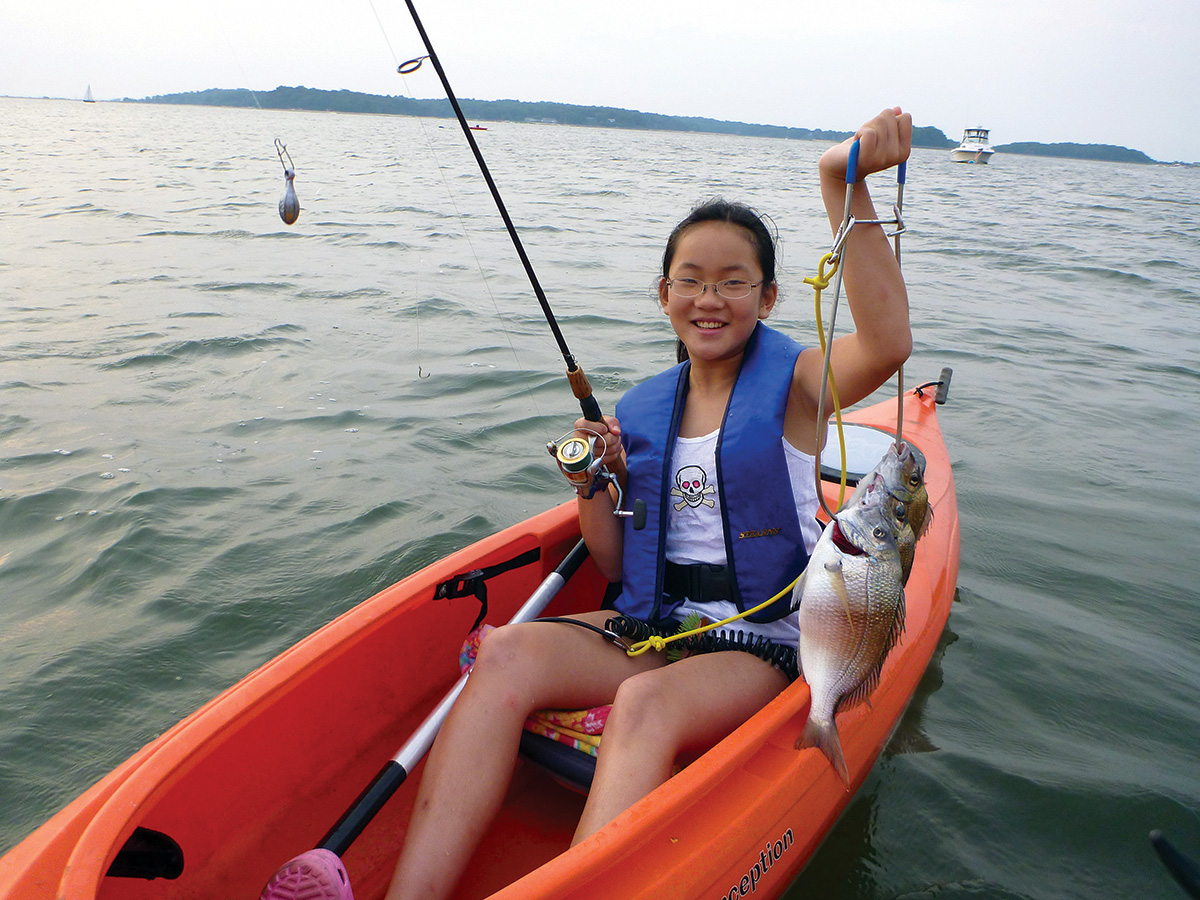
As a final suggestion, I’d like to point out how kid-friendly this type of fishing is. Many types of kayak angling are either too risky or require a higher level of skill than many children possess. Not so with shallow-water porgying. Given the seasonally warm water, close proximity to shore, and abundant, easy-to-catch fish, it’s a kind of kayak angling tailor-made for youngsters. For many years my daughter has accompanied me on such trips. I set up anchor while she paddles nearby, then I bungee the two ‘yaks together to fish. Of course, kids love trying to bat mussels over the side. If you plan on putting them to work on this task, be sure to bring some extra mussels in case they get a little too enthusiastic.
There’s a common perception among many anglers that the farther and deeper one goes, the larger the fish will be. Porgies, more than any other fish I can think of, prove that sometimes the opposite is true. Chasing porgies in the shallows from a kayak also allows one to use scaled-down tackle that really lets the awesome fighting ability of these saltwater panfish shine. This would be a winning angling method at any time of the fishing season, but is especially welcome during the doldrums of late summer when porgies may be the only game in town.

